Table of contents:
What is Audacity?
9 Audacity alternatives to try
Riverside
Ardour
Ocenaudio
WavePad
Tenacity
Adobe Audition
GarageBand
Reaper
Sound Forge Audio Studio
Tips for choosing an Audacity alternative
FAQs about Audacity alternatives
Key takeaways:
- When looking for an Audacity alternative, consider your use case, required features like multitrack editing and recording, system compatibility, and ease of use.
- For podcasting, choose Riverside (which is best overall for recording, editing, and remote interviews)
- For music production, top Audacity alternatives include GarageBand for Apple users and Reaper.
- For quick audio cleanup or voice work, Ocenaudio and WavePad are great lightweight options.
For years, Audacity has been the go-to free audio editor.
But, let’s be honest: it’s also clunky, a little old-school, and missing the modern features we’ve come to expect from recording software. Add in some privacy concerns after its 2021 acquisition, and it’s no surprise people are searching for other options.
Ready to upgrade your audio setup? Here are 9 of the best Audacity alternatives worth trying.
What is Audacity?
Audacity is a free, open-source audio editor popular with podcasters, musicians, and hobbyists. It’s beginner-friendly and covers most basic editing needs. But its interface is outdated and lacks modern editing tools.
When Muse Group acquired Audacity in 2021, its new privacy policy raised concerns about potential data collection and third-party sharing. While the company later clarified its stance, many creators moved on to newer, easier, and more privacy-focused options.
Whether you’re looking for an alternative as a result of Audacity acquisition or because you need different features, we can help with our list below.
9 Audacity alternatives to try
Looking for an Audacity alternative? We’ve got you! Here are 9 Audacity alternatives to consider.
Riverside: Best overall
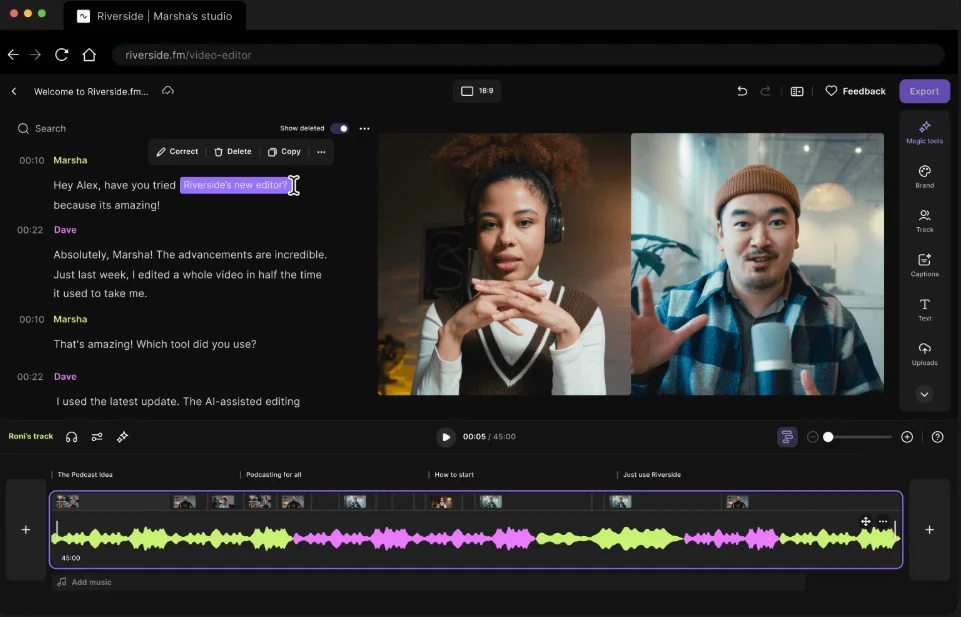
Price: Free plan available. Paid plans start at $24/month.
Riverside offers many of the same tools as Audacity, plus a whole lot more. Like Audacity, you can record and edit your content on Riverside.
But, unlike Audacity, with Riverside, you can edit your audio just by prompting your new AI editing agent, Co-Creator. Ask it to clean your audio, cut only to the good parts, or add sound effects. And, you still have full control so you can edit manually if you prefer.
With text-based editing, adjust recordings just by editing the transcript. There’s also an array of clean up tools for audio enhancement, EQ filters, background noise removal, and more.
Not to mention that you can also record, stream, and edit video. Record in up to 4K resolution with up to 10 remote guests. Your quality stays crisp because everything records directly from each person’s device.
Riverside is the choice for podcasters and creators. The free plan includes most of its AI features, but the paid plans give you a bang for your buck because it truly is an all-in-one platform.
Key features:
- Capture crisp 4K video and studio-grade 48 kHz audio, right from your browser. Export in WAV lossless audio for professional quality sound.
- Record each person on a separate local track for easy multitrack editing and stellar sound.
- Use Co-Creator to edit and repurpose your content using simple prompts.
- Send a link, hit record, guests can join from anywhere, no subscription required.
- Edit in minutes with a text-based editor or jump into the timeline for detailed tweaks.
- Let Magic Audio, Riverside’s AI-powered audio enhancer, polish your sound automatically, no mixing skills required.
- Cut silences and “ums” with a single click.
- Browser and mobile access let you record anytime, anywhere.
Pros:
- Free plan.
- Very easy to use.
- Supports both audio and video.
- Features a range of useful AI tools.
- Excellent customer support, including 24-hour assistance over live chat or email.
User review: “Unmatched audio and video quality are the highlights of the device. Riverside provides us with the same quality as a live broadcast but from a distance, which is very convenient for us to work with specialists and clients from all over the globe. The independent, high-quality recordings for every individual make it so that our after-production work becomes very easy and quick.” — Anastasia T., VP of Marketing
Cons:
- May not be suitable for deep audio production.
- Limited plugin support.
Ardour: Best for professional audio production

Price: Free.
Ardour is a free, open-source digital audio workstation (DAW) for recording, editing, mixing, and mastering audio. It is often considered a professional-level tool compared to Audacity because it offers more advanced mixing, routing, and production capabilities.
This level of functionality and customizability comes with drawbacks: There’s a steeper learning curve. And, you’ll need more computer power along with proper audio hardware and driver setup.
If you’re a more experienced audio editor who wants a full studio workflow, Ardour might be for you. If you’re looking for something simpler, look elsewhere.
Key features:
- Record unlimited audio and MIDI tracks.
- Non-destructive editing tools preserve your original takes.
- Built-in EQ, automation, and routing for precise mixing.
- Supports VST, LV2, AU, and LADSPA plugins.
- Works with live instruments and MIDI side by side.
- Customizable through open-source extensions.
Pros:
- True multitrack mixing and mastering functionality.
- Real-time, non-destructive editing.
- MIDI and instrument support.
- Exceptional plugin support.
- Video and post-production support.
Cons:
- Very steep learning curve.
- Uses a lot of CPU, RAM, and disk bandwidth.
- No built-in AI or smart tools.
- Limited video support (you can import and sync video but not edit).
User review: “It is a user-friendly program that enables one to record and edit a soundtrack with ease. It is easy to learn compared to other programs like Adobe Audition. But it will take you more time to learn if you are green in audio editing knowledge.” — Verified User in Marketing and Advertising from G2.
Ocenaudio: Best for quick audio cleanup
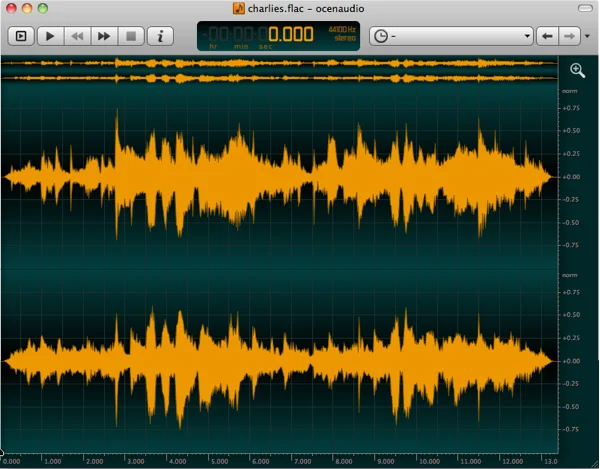
Price: Free.
Where Ardour is known for being more complex than Audacity, Ocenaudio is known for being clean and easy to use. This free audio editor is modern, lightweight, and works well for quick audio trimming or processing, making it especially useful if you don’t want to deal with a cluttered UI full of tools you’ll never use.
This editor is much faster for everyday edits thanks to its real-time effects preview, drag-and-drop functionalities, and easy waveform zooming. It’s also beginner friendly, even for those who don’t have audio engineering experience.
Key features:
- Record and edit audio through a clean, easy-to-use interface.
- Preview effects in real time before applying them.
- Edit non-destructively to preserve the original recording.
- Select and modify multiple sections of a track simultaneously.
- Apply built-in filters and compatible VST plugins for sound enhancement.
- View recordings using both waveform and spectrogram displays.
- Adjust volume, fades, and trims efficiently through direct controls.
- Manage large audio files with stable performance.
- Export projects in common formats, including WAV, FLAC, and MP3.
Pros:
- Free.
- Easy to use.
- Efficient for batch trimming and corrections.
Cons:
- No multitrack recording or editing.
- Strictly audio, with no music composition tools.
User review: “It is free. It has all the core functions that you need, but it lacks many features. It has a lot, but is still pretty basic compared to other DAWs.” — Kyle S., Data Wizard
Wavepad: Best for light editing and voice work

Price: Free plan available. Paid versions start at $5.50/month.
WavePad is an audio editor that, while not open source, includes a free basic version that is quite beginner friendly.
It has a rich library of effects built right in, which means you may get more out of the box than you do with Audacity without having to deal with plugins. It’s also good for batch audio edits and even includes a mobile version you can use on phones and tablets, which Audacity doesn’t.
Key features:
- Record and edit audio using professional tools in a simple interface.
- Work with multiple tracks to combine voice, music, and sound effects.
- Cut, trim, and clean recordings with straightforward editing controls.
- Apply effects such as reverb, EQ, and compression, and hear changes right away.
- Use batch processing to edit or convert many files at once.
- Reduce noise and fix clicks, pops, or hiss in older recordings.
- Add VST plugins for additional mastering or sound design options.
- Edit non-destructively so changes can be undone or adjusted later.
- Export audio for video, podcasts, or music in standard file formats.d.
Pros:
- Better support and resources than Audacity.
- Modern interface.
- Mobile version.
Cons:
- Downloadable application means it’s less portable and more resource heavy.
- No remote recording features.
- Video editing only available as a paid add-on.
- Only single track editing available in the free version.
User review: “WavePad is an ideal tool for basics in editing audio files. It is super easy and it has everything for the beginner's needs. The number of functions is limited, but for me, it is enough.”” — Verified User in Research from G2.
Tenacity: Best for privacy-focused users
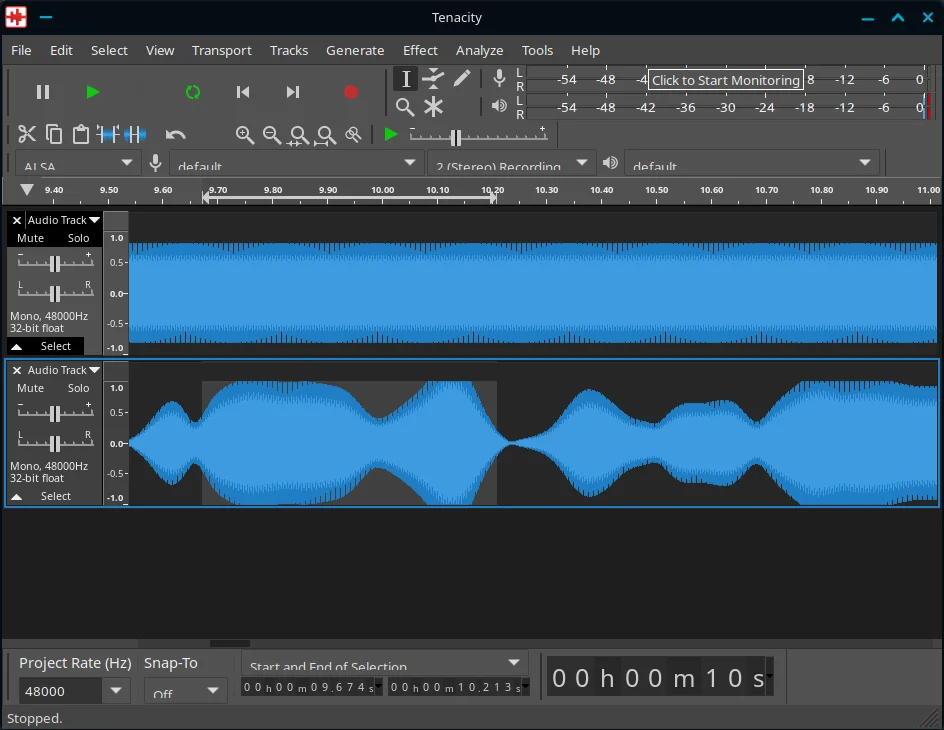
Price: Free.
This free, open source platform was originally derived from Audacity’s code base and split off with changes to address community concerns. It has similar recording and editing features as Audacity, except that it lacks some features because it’s still under development.
If you love Audacity and just want an open source tool that is truly steered by its community, Tenacity might be the ticket. Note, however, that it may not be as stable and reliable as Audacity, as it’s still relatively young.
Key features:
- No user data is collected; the software is completely private.
- Record and edit audio using open-source tools.
- Supports multiple tracks for podcasts, music, and voiceovers.
- Non-destructive editing keeps the original recordings intact.
- Includes tools for cutting, fading, and cleaning audio.
- Offers effects, EQ, compression, and plugin support.
- Provides waveform and spectrogram views for detailed editing.
- Allows automation of volume and fades.
- Exports audio in formats such as WAV, FLAC, OGG, and MP3.
- Lets you customize shortcuts, themes, and tool layouts.
Pros:
- Modern UI tweaks and usability improvements compared to Audacity.
- Can be used offline.
Cons:
- No video editing support.
- Lacks a few features found in Audacity, like looping and the Mixer Toolbar.
- Stability and maintenance concerns.
- Limited documentation.
Adobe Audition: Best for professional post-production
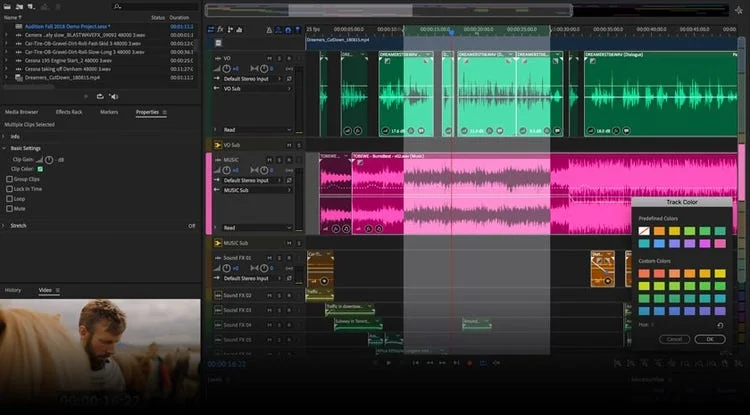
Price: $22.99/month.
Adobe Audition is a powerful, professional audio workstation. Because it’s part of the Adobe Creative Cloud ecosystem, it integrates well with other Adobe products, like Adobe Premiere (for video editing) and Adobe After Effects (for motion graphics).
Audition is a full stack editor that’s suitable for professional audio editing, finishing, and restoration, and includes a stable, polished UI. Many professional audio editors rely on this program, but it has a steep learning curve and may be overkill for beginner editors or more basic editing needs.
Key features:
- Record multitrack audio with professional sound quality.
- Edit non-destructively with real-time waveform previews.
- Remove background noise, reverb, and echo using built-in AI tools.
- Adjust levels and repair dialogue through the Essential Sound panel.
- Mix multiple tracks using EQ, compression, and automation features.
- Use spectral editing to locate and remove unwanted sounds visually.
- Integrates with Premiere Pro for combined audio and video editing.
- Supports a wide range of effects and third-party VST/AU plugins.
- Exports audio in standard broadcast and distribution formats.
- Sessions can sync across devices through Creative Cloud.
Pros:
- Industry-leading, professional quality audio editor.
- Scalable and suitable for large projects, numerous tracks, and complex edits.
- Consistent updates and excellent support.
Cons:
- Subscription cost adds up.
- Steep learning curve.
User Review: “Audition feels like it was designed for people who take audio seriously but still need to move quickly. The biggest downside is that it’s only available through a monthly subscription. For freelancers/occasional users who aren’t using it every single week, that can get pricey compared to one-time-purchase alternatives.” — Brandon G., Remote Online Notary Public
GarageBand: Best for music production
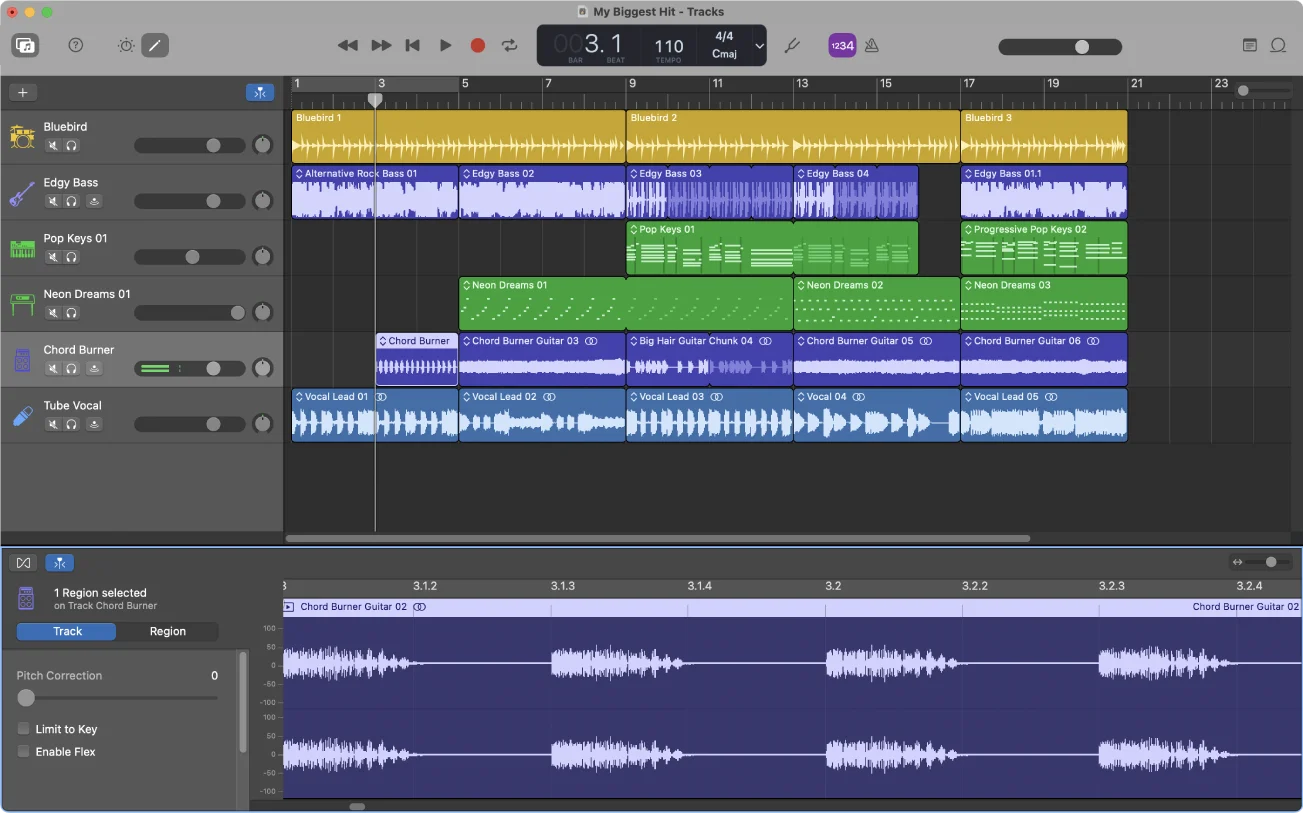
Price: Free.
Garageband is Apple’s free digital audio workstation and music production software. It’s aimed at beginner to intermediate users, and a lot of Apple fans rely on it to create music, podcasts, and other recordings.
It’s simpler than Apple’s Logic Pro (the company’s paid, pro-level DAW), but still powerful enough for most creative uses. It’s especially well known for its built-in library of virtual instruments you can play with a MIDI keyboard or even your Mac keyboard. Best of all, it has a nice UI and it’s easy to use, even with all the relatively high-level features.
Key features:
- Record vocals, instruments, and loops in a simple interface designed for beginners.
- Arrange songs by dragging and dropping tracks or using Apple’s Smart Instruments.
- Mix multiple tracks with real-time effects and automation.
- Apply EQ, compression, and reverb using built-in tools.
- Includes virtual amps, drummers, and synthesizers for creating full arrangements.
- Supports non-destructive editing, allowing changes without overwriting recordings.
- Works with microphones, guitars, and MIDI keyboards for direct recording.
- Exports audio to Apple Music, SoundCloud, or local storage.
- Projects can be accessed across iPhone, iPad, and Mac through iCloud.
Pros:
- Free.
- Easy to use.
- iOS version for mobile use.
Cons:
- Only works on Apple devices.
- Less advanced editing features compared to Audacity.
- Narrow use case (more focused on music creation).
User review: “The software might feel limiting for advanced users seeking more intricate controls or additional plugins for fine-tuning their compositions.” — Shobhit G., Product Manager
Reaper: Best for full-scale audio production
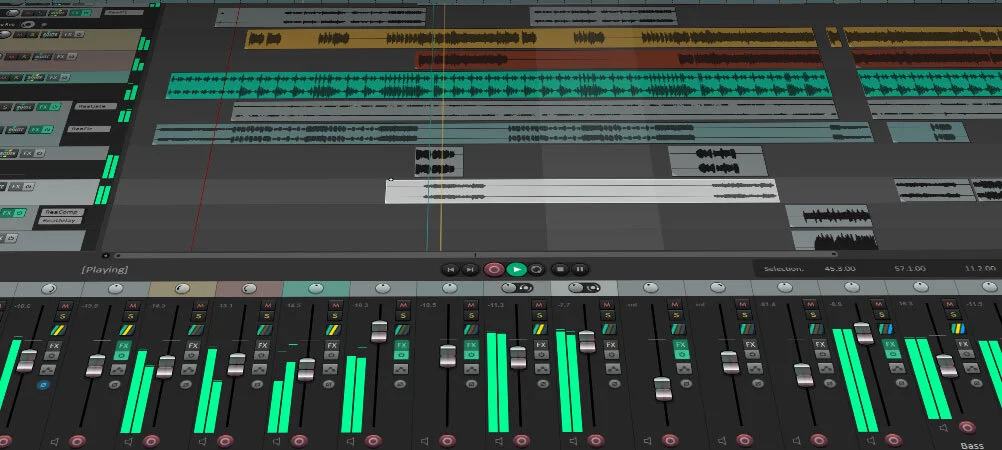
Price: $60 for a discounted license; $225 for a commercial license.
Reaper is another full-feature digital audio workstation. It’s flexible, powerful and (while not free) provides good value for a low licensing fee.
It’s famously lightweight and runs on modest hardware, but can still handle massive multitrack sessions with hundreds of plugins. And, almost every part of it (menus, shortcuts, colors, toolbars, etc.) is customizable. In a nutshell, you get almost all the power of pro DAWs and lots of community support for a fraction of the cost of many others in its class.
Key features:
- Record unlimited audio and MIDI tracks.
- Edit non-destructively with precision and full undo history.
- Mix hundreds of tracks with advanced routing, buses, and automation.
- Customize your entire workflow (toolbars, themes, and shortcuts)..
- Add any VST, AU, or JS plugin for professional-grade effects and instruments.
- Customize Reaper with your own scripts or add-ons to fit your workflow..
Pros:
- 60-day free trial and discounted license make it affordable.
- Excellent recording and editing tools.
- Powerful mixing and routing tools.
- Highly crash resistant and widely recognized as stable software.
Cons:
- Steeper learning curve may be overwhelming for beginners.
- No official mobile or browser version.
- Some manual setup required.
User review: “Reaper is incredibly accessible and has all the inbuilt modules to create a professional experience. At first, using the reaper was a bit daunting.” — Augustine V., Music Producer
Sound Forge Audio Studio: Best for mastering and restoration

Price: Free trial. Paid plans start at $4.49/month.
Sound Forge is a digital editing suite aimed at professional and semi-professional users. Compared to Audacity, it provides more advanced mastering, cleanup, and batch editing tools.
It’s been trusted by professionals for decades and is still considered one of the most accurate waveform editors for detailed cleanup and mastering.
Key features:
- Record, edit, and master audio with precise control.
- Remove noise, clicks, and hums using built-in restoration tools.
- Supports recording at up to 64-bit/384 kHz quality.
- Preview effects in real time before applying changes.
- Batch-process large numbers of files automatically.
- Includes tools for mastering to broadcast standards.
- Allows editing and synchronization of audio with video.
- Available in two versions: Audio Studio for general use and Pro for advanced mastering.
Pros:
- Longstanding reputation for stability.
Cons:
- Free trial but no free version.
- Heavier on system resources (not ideal for older machines or light laptops).
- Not a multitrack editor (can’t mix multiple tracks together).
User review: “I like Sound Forge for its powerful editing tools. It is simply a top-notch software when it comes to audio recording, editing, mixing, and mastering. But it doesn't have a lot of options for noise reduction.” ” — Irfan, Media Producer
Tips for choosing an Audacity alternative
Still need some help narrowing down your choices? Here are a few tips to help you find the best Audacity alternative for your needs.
Define your use case
Why you want an Audacity alternative may be the most important factor in helping you find the right alternative. If you’re:
- A podcaster, consider an option that allows for remote recording, like Riverside.
- A music producer, dig into the options that have the best features for musicians, like GarageBand.
- Looking for a quick, casual editor, prioritize one that’s easy to use, like Riverside or WavePad.
- If you love Audacity but are concerned about privacy, try Tenacity.
Verify compatibility
Not all software is compatible with all systems. Check that the software you are considering works with your operating system and that you meet system requirements to run the program.
Some audio editing software is fairly resource heavy, and may require a newer, higher-powered computer to operate properly. Browser-based software like Riverside tends to be lighter weight, making it compatible with more systems.
Consider ease of use and learning curve
Some audio editing software is known for having a serious learning curve, Audacity included. Consider:
- How much experience you have.
- The features you need.
- How much time you are willing to invest into learning a new platform.
Generally speaking, the more features you get, the more complex the program. Focus on choosing a software that provides the features you’ll use, and fewer of the features you’ll never need.
Explore plugins
Plugins are add-ons that expand an editing software’s capabilities. The most common plugin format is VST/VST3.
But some DAWs, like GarageBand and Logic Pro, don’t support VST plugins, so you can’t use many third-party effects or virtual instruments without workarounds. If you plan to use specific synths, effects, or mastering tools, make sure they’re compatible with your DAW’s plugin format.
Check supported formats
Look at the kinds of audio files your editor can open, import, export, or record. Here are a few tips:
- Make sure your audio editor can record, import, and export in WAV (uncompressed) or FLAC (compressed but lossless). Some simpler editors only handle MP3, which is fine for casual use, but not for professional mixing or mastering.
- Check if the editor includes direct export options for MP3 or AAC (some require a separate encoder plugin).
- Consider what file formats are most useful for your projects and ensure that your editor exports in these formats.
Evaluate performance and stability
Some audio editors are known for excellent performance and stability. Others? Not so much. Read reviews and forums to get a sense of which editors deliver the best performance and which are more likely to freeze or crash.
Determine whether you need non-destructive editing
Some audio editors are non-destructive, which means every change you make is applied virtually and can be rolled back easily. Audacity is partially destructive (more minor edits can be rolled back, but effects cannot). If you’re only doing minor edits, this (or even a fully destructive editor) may be fine.
Weigh price point
Price is always a consideration when shopping for an audio editor, but it’s important to assess not just what you pay, but also what you get.
Many free, open source editors like Audacity lack customer support, while paid options are more likely to provide it. Some editors, like Riverside, are also packed with features to make editing faster and easier. This can make them more worthwhile, even if you choose a paid plan.
FAQs about Audacity alternatives
Who owns Audacity?
Audacity was purchased in 2021 by Muse Group, a Cyprus-based company that owns other well-known music and audio tools. Muse Group continues to develop Audacity as free, open-source software under the GPL license, meaning users can still access, modify, and redistribute the code.
Do professional musicians use Audacity?
In general, no. Audacity is intended for sound editing rather than music production. So, while you can record and layer multiple tracks in Audacity, its waveform editor isn’t a true mixing environment. It also has limited plugin support, which means you can’t use virtual synths, drum machines, or samplers, which are core tools for music producers. Audacity also lacks mixing and mastering tools designed for music production.
Many musicians use professional DAWs like Ableton Live, Logic Pro, or Pro Tools. Some more entry level options include GarageBand and Reaper.
Is Tenacity better than Audacity?
No, but it’s different. Like Audacity, Tenacity is a free, open-source audio editor and recorder. It’s based on Audacity’s open-source code and was developed to be like Audacity, but it also aims to address some of the privacy concerns introduced by Audacity’s new owners.
Tenacity has a lot of the same features as Audacity, but has some different UI elements. Overall, though, Tenacity is less developed and lacks support compared to Audacity, so development may be slow. Tenacity also lacks a few of the newer Audacity features, such as VST3 plugin support and its new looping features.
Is Audacity still destructive?
Audacity introduced non-destructive editing in version 3.1.0, released in October 2021. Before version 3.1, nearly all edits in Audacity were destructive. Once you cut or deleted a section, it was gone from the project unless you used the undo function or had a backup copy.
However, Audacity is only partially non-destructive. Arranging and basic editing is easily rolled back, but filters, effects, and mixing are still destructive changes. Some fully non-destructive options on our list include Reaper and Ardour.
Is Audacity still free?
Yes, Audacity is still 100% free to use. Its current developers plan to keep it free for everyone forever. Audacity does charge for Audacity Cloud Storage, which allows you to save projects on the cloud.














-(1).webp)
.webp)
.webp)
.webp)




